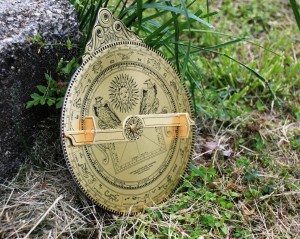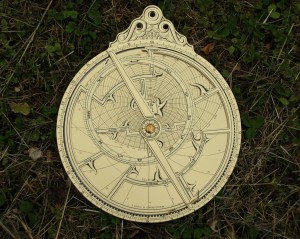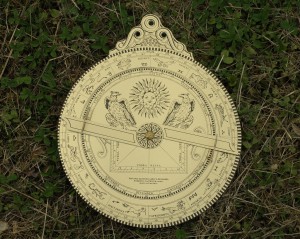My doctoral research focused on instruments derived from Ptolemaic principles. However, one of the observatories on which I based my project was also associated with an astrolabe foundry during the first half of the 18th century. Technically, astrolabes aren’t Ptolemaic. The stereographic projection on which the astrolabe depends was first described by Hipparchus c. 150 BCE, some 250 years before Ptolemy described it in his Planisphaerium (2nd c. CE). All the same, I could see needing to explain functionality of the instrument to my dissertation committee, so I started keeping track of the better resources on the instrument in my research notes.
A few fragmented astrolabes exist at one of my research sites, mostly in the form of tympani missing the necessary moving parts (the rete, rule and alidade) to make them useful. Staring at the tympani didn’t do me much good and my reading made sense in theory, but lacked practical examples. I really didn’t want to find myself standing in front of my examination committee, stammering for an answer when they asked me to explain how to use an astrolabe to determine local solar time.
Enter Adler Planetarium, the sole purveyor of Roderick S. Webster’s Astrolabe Kit, the solution to my problem.* I’m a great believer in hands-on learning experiences. If you want to know how something works, try building it for yourself. Or try putting it back together after you’ve taken it apart. It works with construction methods used in residential design and, as it turns out, it also works with astrolabes.
Webster’s kit is a little pricey (around $20) but I think I’ve gotten twenty bucks worth of entertainment and education out of it. It took me about three days to build the thing because of its complicated glue demands. Without glue, it would’ve required 30 minutes, tops, including sanding the rough edges and assembly. Learning how to use the thing is been a different matter. I’ve spent (literally) hours sitting at my desk working through the various problems it’s supposed to help me solve. Local skies have been persistently overcast, so I’ve been using Stellarium to help me determine the altitudes of various stars (if the skies ever clear up, I’ll be able to sight them through the rule on the back of the astrolabe. IF THE SKIES EVER CLEAR UP.). I’m currently using the tympanum set up for a latitude of 42 degrees. That gives me the skies about Barcelona (41 23 N), Marseilles (43 20 N), Rome (41 54 N), Sofia (42 40 N), and Vladivostok (43 10 N) with which to play this evening.
And playing is what I’ve been doing. Sidereal time, solar time, time from the sun, sunrise and sunset, the positions of the moon and planets, rising and setting of a few major stars… Some calculations are working better than others, but I’m not quite sure why. Once I’ve determined the latitude of a star and set the rete, I never move it, no matter what problem I’m trying to solve. It’s a bit of a mystery as to why one answer is immediately obvious and the next isn’t, but it’s also a bit of fun.
*N.B. I spent an outrageous amount of time trying to find the kit in the newest version of Adler’s online store, yet still failed to locate it. You might have to call them if you really want one.



I absolutely love the astrolabe! Can it be purchased fro somewhere. Great instrument for teaching.
Thanks for any response
Ed Dufresne
I purchased mine from the Adler Planetarium Store (http://www.adlerplanetarium.org/plan/store). You might have to contact them directly and ask, though–the website doesn’t seem very complete.
Hi
Thank you for the info I appreciate it.
I ended up purchasing it from celestaire ( nav equiptment)
I put it together as instructed and it came out perfect. It is amazingly accurate,
and looks great. I’m going to purchase the Trilogy of Time from Celestaire .
I also purchased Dennis Fisher’s book Latitude Hooks and Azimuth Rings absolutely informative and 18 projects to build. Worth every cent! Thanks again.
Additional info:
Celestaire.com sells the Astrolabe for $24 and that is very inexpensive in my opinion for the quality cutouts to make this astrolabe.
The Trilogy of time sell for $18 it has the same quality cut outs as the Astrolabe and is comprised of a Nocturnal for telling time very accurate. A perpetual calendar and a Sundial.
The Latitude Hooks and Azimuth Rings by Dennis Fisher sells for $19.95,
Plus the sell some very inexpensive sextants and some very expensive sextants
and Navigational equiptment.
Excellent–thanks for posting the information. I think I’ll look into the Dennis Fisher book. My next project will be making a sextant out of a CD cover (http://www.tecepe.com.br/nav/CDSextantProject.htm).